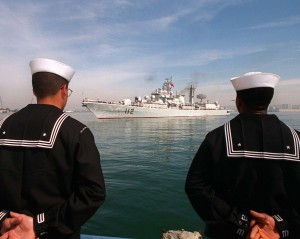 There is nothing inherent in the Chinese Navy that makes their fleet more successful than anybody else’s in the world. By rights, the PLA(N) shouldn’t move the needle; the Chinese Navy is growing, but it is still small, relatively low-tech and untested. It’s just that the Chinese government has, for the past quarter-century, used their Navy in a far more effective strategic fashion than anybody else out there today.
There is nothing inherent in the Chinese Navy that makes their fleet more successful than anybody else’s in the world. By rights, the PLA(N) shouldn’t move the needle; the Chinese Navy is growing, but it is still small, relatively low-tech and untested. It’s just that the Chinese government has, for the past quarter-century, used their Navy in a far more effective strategic fashion than anybody else out there today.
China has put their middling Navy to good use; in fact, it is hard to come up with a major mis-step. The China’s Navy-led expansion into the South China Sea, the consolidation of holdings there and the vigorous actions that helped transform the first island chain into a strategic “barrier” have done wonders for the Chinese government. When the government needs something nicely nationalistic and robust to happen, the Chinese Navy delivers. Topping it off, this all has been won with comparatively little investment, and grasped by a comparatively slap-dash set of “good-enough” naval platforms.
In contrast, the U.S. Navy, after investing far, far more in platforms and resources, has not been as effective as the PLA(N) in furthering a national strategic goal. It isn’t for lack of trying; U.S. policymakers have either provided bad goals or, at best, failed to articulate America’s strategic interests they want the Navy to focus upon, leaving the Navy to dash aimlessly from one crisis to another. (The Navy, to it’s credit, has tried to make crisis response a strategy, but, again, that strategy lacks an end-state goal or strong, selfish, nationally self-interested rationale.)
At any rate, in terms of tangible, enduring strategic benefit, the U.S. Navy’s yield is less than the PLA(N).
This isn’t meant as a slight to the U.S. Navy, and I am, admittedly, painting with a broad brush here–deliberately overlooking/minimizing key naval tasks like the nuclear deterrence mission (which, for all my readers with a stake in SSBN(X), is not supported in our current list of key American interests) or the undercover work done by SSNs. Over the past twenty-five years the U.S. Navy has done a wonderful job responding to crises, and chalked up an amazing record in disaster-response, rapid-reaction and power-projection. And as America’s 9-1-1 force, the Navy does well for the country. But, since the Cold War, America’s dominance at sea has not been tightly lashed to a larger, long-term strategy, and that has reduced the Navy’s overall effectiveness at furthering enduring American interests.
The U.S, Navy, being content to largely serve as an “all-hazards crisis response force”, has, in some respects, moved away from setting its own strategic goals–and then using that strategy to help inform national goals for the rest of the government. I think CNO Greenert has made a good start on changing that dynamic with his “Sailing Directions“, but large-scale strategic frameworks like Plan Orange or the 600-ship Navy–those types of grand plans are no longer around.
But, overall, over the past 25 years, the U.S. Navy–and the rest of the U.S. government–has failed to find, fix and focus upon a set of well-thought-out strategic goals.
For the Navy, this failure carries longer-term consequences that we will discuss over the coming days.
(And for the sake of discussion, the runner-ups for the “most strategically successful Navy in the world over the past 25 years award” were Japan, Israel and….Sri Lanka.)

{ 2 comments… read them below or add one }
Yep. Point taken. I do think we should get back to the idea of a national fleet so we don’t immediately discount Coast Guard or naval militia when mulling naval strength.
Not that the PLAN was not backup, but the pointy end of the spear, in staking a claim to virtually all the waters inside the first island chain, has actually been China’s coast guard organizations.